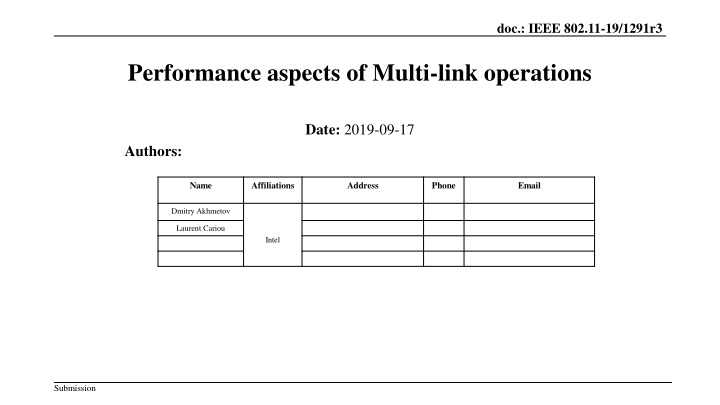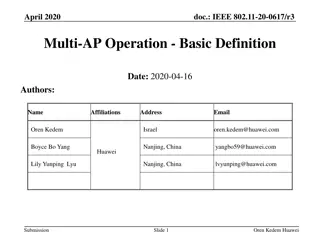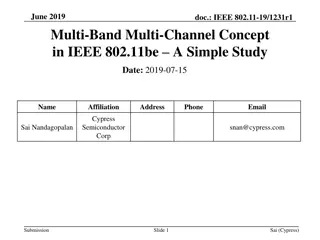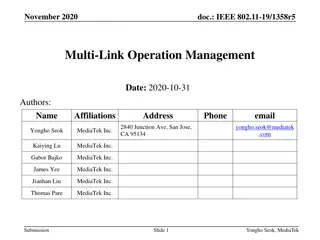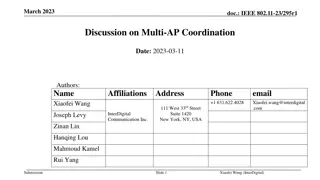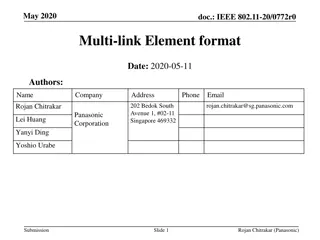Performance Aspects of Multi-link Operations in IEEE 802.11-19/1291r3
This document discusses the motivation, assumptions, and classifications related to multi-link operations in IEEE 802.11-19/1291r3 standard. It explores the benefits of multi-link capabilities in new wireless devices, such as improved throughput, reduced latency, and potential for link aggregation. The classifications include completely synchronous, completely asynchronous, and semi-asynchronous operations based on channel access types. Detailed scenarios and procedures for multi-link operations are presented, highlighting the independent channel access and transmission over multiple links.
Download Presentation

Please find below an Image/Link to download the presentation.
The content on the website is provided AS IS for your information and personal use only. It may not be sold, licensed, or shared on other websites without obtaining consent from the author.If you encounter any issues during the download, it is possible that the publisher has removed the file from their server.
You are allowed to download the files provided on this website for personal or commercial use, subject to the condition that they are used lawfully. All files are the property of their respective owners.
The content on the website is provided AS IS for your information and personal use only. It may not be sold, licensed, or shared on other websites without obtaining consent from the author.
E N D
Presentation Transcript
doc.: IEEE 802.11-19/1291r3 Performance aspects of Multi-link operations Date: 2019-09-17 Authors: Name Affiliations Address Phone Email Dmitry Akhmetov Laurent Cariou Intel Submission
doc.: IEEE 802.11-19/1291r3 Motivation for Multi-link operation. EHT MLLE 1 New wireless devices are expected to have multi-band/channel capabilities These new devices will/may be able to operate on different channels/band independently Independent channel access Independent TX / RX operation Unified TX/RX buffers for smooth and speedy operations Benefits Increased/improved throughput Gain scales proportionally to a number of links Improved end-to-end latency Potentially data/mgmt plane separation Potential for link aggregation Enable new use cases STA STA Link 2 Link 1 STA STA EHT MLLE 2 Submission 2
doc.: IEEE 802.11-19/1291r3 Multi-link operation assumptions and classification Assumptions A multi-link capable device perform channel access on multiple channels independently A multi-link device after obtaining TXOP on multiple bands/channels can transmit frames to the receiver(s) over multiple links Classification based on channel access type Synchronous operation Asynchronous operation Semi-Asynchronous operation Submission 3
doc.: IEEE 802.11-19/1291r3 Classification: Completely synchronous (S)ingle (P)rimary (C)hannel, SPC TXOP TXOP TXOP band 1 0 3 2 1 3 2 1 2 1 0 0 STA 1 busy busy busy TXOP band 2 STA 2 Perform contention on primary channel Do energy detect for PIFS on a secondary channel If IDLE transmit over two channels If BUSY transmit on primary only Submission 4
doc.: IEEE 802.11-19/1291r3 Classification: Completely asynchronous, (M)ultiple (P)rimary (C)hannels, MPC TXOP TXOP busy band 1 2 5 4 1 3 0 6 9 8 7 1 0 3 2 STA 1 TXOP busy TXOP TXOP band 2 3 2 0 1 0 2 1 4 3 2 1 0 STA 2 Perform contention independently on both links Transmit independently on both links Submission 5
doc.: IEEE 802.11-19/1291r3 Classification: Semi-asynchronous (J)oin (M)ultiple (P)rimary (C)hannels, JMPC TXOP TXOP TXOP TXOP band 1 0 2 1 4 3 7 6 5 8 9 3 2 1 0 STA 1 busy TXOP busy TXOP band 2 4 3 2 1 0 7 6 2 1 0 STA 2 Perform contention independently on each link If one channel/link won contention - verify status of a another channel/link If another link is PIFS idle/Contention state than transmit jointly Otherwise transmit using on available link only Submission 6
doc.: IEEE 802.11-19/1291r3 Extra clarification on used classification Word synchronous refers strictly to obtaining channel access/initiating TXOP at the same time on more than one link Synchronous operation, SPC Obtain access on a primary link/channel only, initiate TXOP on both link only when secondary link if PIFS IDLE Asynchronous operation, MPC TXOP initiation is completely independent, no synchronization at all Semi-Asynchronous operation, JMPC Channel access attempts are independent, but TXOP initiation can be artificially synchronized in case if one link/channel complete contention and another is PIFS IDLE/active contention state. Submission 7
doc.: IEEE 802.11-19/1291r3 DL case. Simulation setup. SU HE, 2x2x80, MCS11 BSS TXOP limit 5.4ms OBSS STA 1 OBSS STA n OBSS AP n OBSS AP1 STA1 AP1 OBSS TXOP limit: uniformly distributed for each TXOP between 1 and 5.4ms Link 1 EHT AP EHT STA No TXOP bursting OBSS STA2 OBSS AP 2n OBSS STA 2n OBSS AP 2 RTS/CTS on Link 2 AP2 STA2 AMPDU size: 256 BSS load: UDP traffic in DL direction with load of Case 1: 300Mbps, e.g. 25% of MCS11 rate; Case 2: 600Mbps, e.g. 50% of MCS11 rate; Case 3: 1200Mbps, e.g. 100% of MCS11 rate For each case vary number of OBSSes from 0 to 10 Each OBSS has bidirectional UDP traffic with total load 120Mbps ( e.g.10% MCS11 rate) All BSSes are in ED range of each other Metrics of interest Throughput # of synchronous/asynchronous operations ( simultaneous TXOP start) Submission 8
doc.: IEEE 802.11-19/1291r3 Single link vs Multi-link. DL case Submission 9
doc.: IEEE 802.11-19/1291r3 Single link vs Multi-link. DL case Submission 10
doc.: IEEE 802.11-19/1291r3 Single link vs Multi-link. DL case Submission 11
doc.: IEEE 802.11-19/1291r3 Chances of synchronous operation. Submission 12
doc.: IEEE 802.11-19/1291r3 DL/UL mix case SU HE, 2x2x80, MCS11 BSS TXOP limit 5.4ms OBSS STA 1 OBSS STA n OBSS AP n OBSS AP1 STA1 AP1 OBSS TXOP limit: uniformly distributed for each TXOP between 1 and 5.4ms Link 1 EHT AP EHT STA No TXOP bursting OBSS STA2 OBSS AP 2n OBSS STA 2n OBSS AP 2 RTS/CTS on Link 2 AP2 STA2 BA Bitmap 256 BSS load: bidirectional UDP traffic in with a load of Case 1: 300Mbps, 25% of MCS11 rate, Case 2: 600Mbps, 50% of MCS11 rate; Case 3: 1200Mbps, 100% of MCS11 rate For each case vary number of OBSSes from 0 to 10 Each OBSS has bidirectional UDP traffic with total load 120Mbps ( or 10% MCS11 rate) All BSSes are in ED/PD range of each other Metrics of interest Throughput # of synchronous/asynchronous operations ( simultaneous TXOP start) Submission 13
doc.: IEEE 802.11-19/1291r3 Single link vs Multi-link. DL/UL mix case Submission 14
doc.: IEEE 802.11-19/1291r3 Single link vs Multi-link. DL/UL mix case Submission 15
doc.: IEEE 802.11-19/1291r3 Single link vs Multi-link. DL/UL mix case Submission 16
doc.: IEEE 802.11-19/1291r3 Chances of synchronous operation, DL / UL mix case. Submission 17
doc.: IEEE 802.11-19/1291r3 Conclusion 2 links is definitely better than 1 link Depending on a type of operation and network load 2x gain (or more) can be easily achieved The gain remain mostly constant for all modes of operation except synchronous which quickly drops from 2x to 1.2x JMPC operation outperform on average all other modes but Brings uncertainty in terms of fairness Brings complexity in implementation Chances for synchronous operations on two bands (i.e. to obtain channel at the same time) are not high Quickly drop to ~5% and below as the load and number of contending devices increases MPC operation performs very close to best performance and is therefore the preferred solution without the fairness issues does not require any extra work to implement/support Average performance gain from multi-link operation DL case - 2.07x; DL / UL mix case - 2.02x SPC mode of operation: DL case: 1.27x; DL / UL mix case: 1.29x JMPC mode operation: DL case: 2.28x; DL / UL mix case: 2.22x SPC mode of operation performs very poorly, except when there s no OBSSs/light load on the second link Not a good solution to consider For the future simulation we will concentrate on MPC operations only MPC mode of operation: Submission 18
